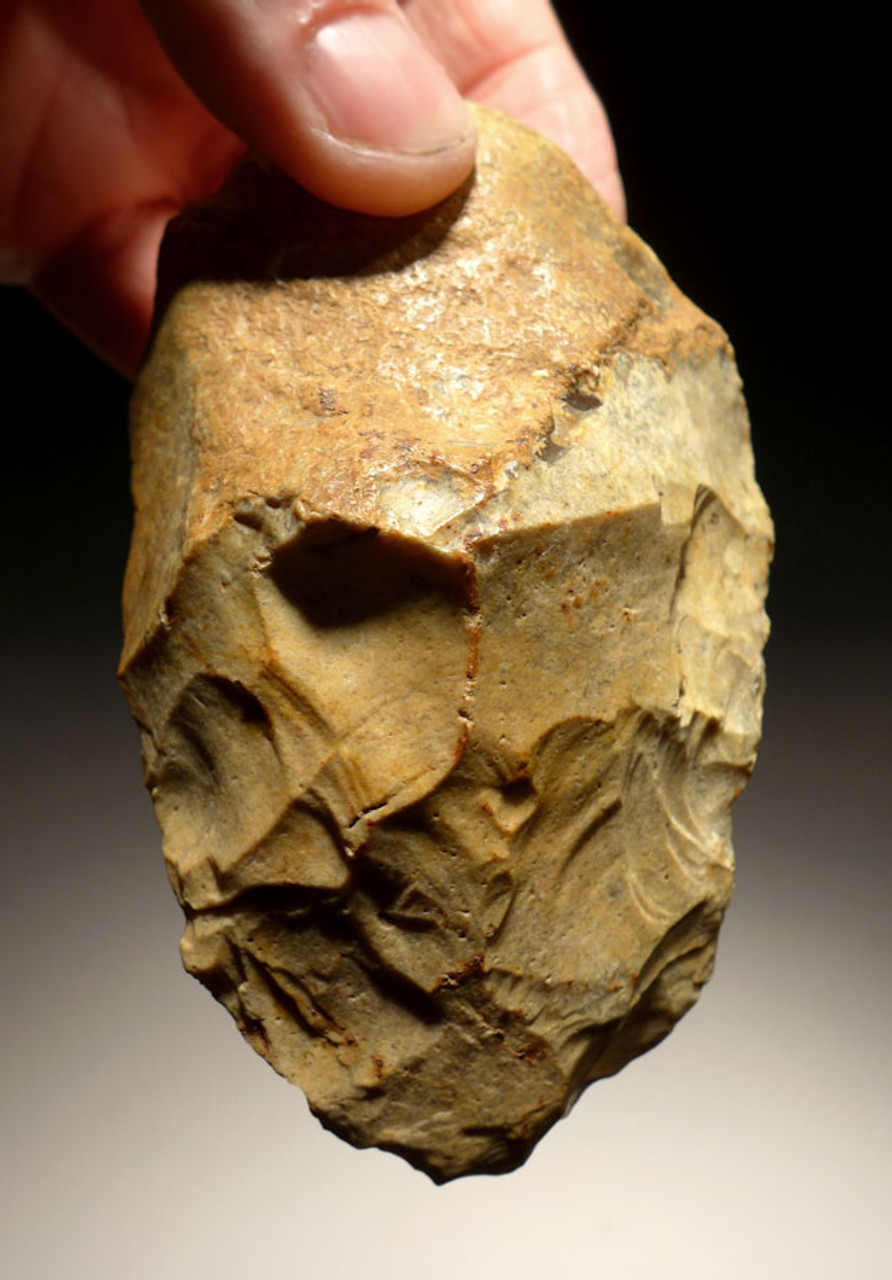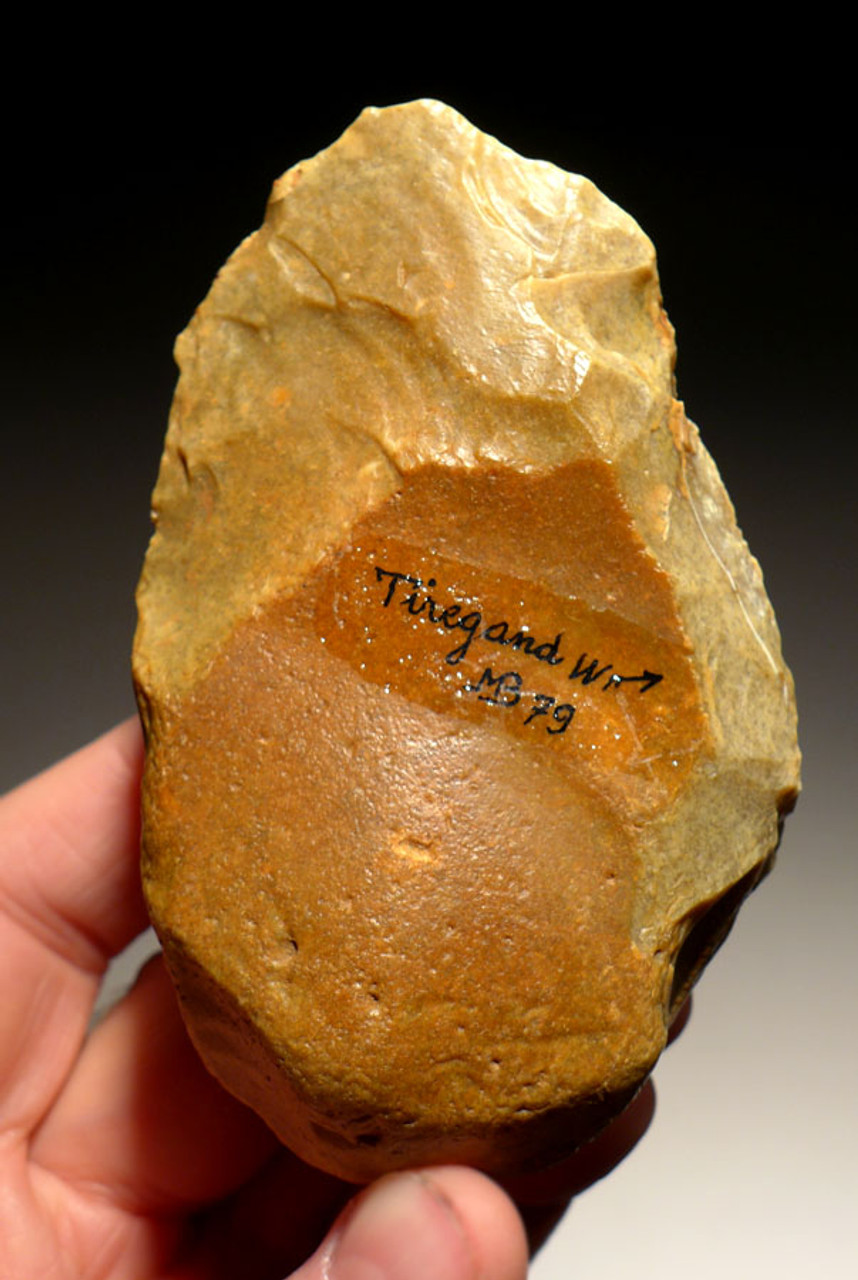Product Description
Over the years, we have offered some of the finest Paleolithic European artifacts on the market but this hand axe ranks as one of the finest and most unique examples we have listed to date. It is a rare French Acheulian prehistoric handaxe, fashioned by Homo erectus (H. heidelbergensis), the first humans to occupy Europe. Its prehistoric maker created an ingenious design by keeping the natural rounded cobble end for an ergonomic grip similar to an earlier Oldowan Pebble Tool technology. The later Acheulian Period is evident in the very fine and delicate secondary flaking that is seen in the superbly detailed workmanship on the distal, chopping end.
Displaying a remarkable golden greenish patina on the Bergerac flint, the natural outer cortex of the cobble contrasts with a stunning burnt pumpkin orange patina formed over hundreds of thousands of years. The surface of the flint shows a soil sheen from mineral deposition, giving it the appearance it was polished. This MUSEUM-CLASS biface handaxe displays workmanship on the highest level and its early human creator was certainly highly skilled in the form and function of this magnificent specimen! Bifacial flaking around portions of the original flint nodule are for finger rests and a refinement of the grip. The tip is still intact as it was the day it was made. This is a left hand use design. The skill and workmanship to form this axe and achieve the flaking is magnificent and represents a remarkable understanding and achievement in Early Human tools.
This specimen dates back to the Acheulian Period. The Acheulian Tradition was the predominant tool technology of the Homo erectus people in Europe currently dating back as far as 900,000 years ago. Fine quality European Acheulian hand axes are far more rare than their Saharan counterparts and often move swiftly, from one private collection to the next as many sites are now destroyed, built over or protected. In the past decade, European auctions have routinely set records for the highest prices realized on spectacular examples of Prehistoric European artifacts like this. Finest grade specimens are so few in number while the buyer market continues to expand and chase after the best material with no apparent price ceiling in sight. Nevertheless, the prices STILL, are a paltry comparison to much of the more mature rare collectibles on the market and Paleolithic artifact prices still really don't reflect the substantially higher rarity of these artifacts. As ever-increasing buyer demand continues to pursue the best pieces, the actual number of this material is sobering and we are likely to see prices easily rise ten-fold on top-grade specimens, in the next several years. The words "undervalued" and "collectible" are seldom found together in today's world but the realm of European and African Paleolithic artifacts is one where you can still find an emerging market and one of the greatest promises for future appreciation.
From a very old former French collection. Today, digging for new specimens is forbidden and has been for decades with most of the best pieces being found in the first half of the last century. Finding an exquisite piece like this ONLY comes from coveted old collections in Europe and hand axes like this usually move from one collection to the next in private collector circles, rarely making it out of the country. Very highly recommended! No Paleolithic collection should be without representative tools of Europe's first humans!
WARNING: This specific specimen possesses a fine prehistoric patina and mineral deposits. Such traits are missing in the fake tools being passed off as genuine tools by fraudulent and/or uninformed dealers selling in auctions, online, at shops and shows. The market is currently awash in fakes and ancient debris rock shards sold as genuine Paleolithic tools. Make sure you get an unconditional certificate of authenticity and know your dealer is knowledgeable AND informed.
 US DOLLAR
US DOLLAR
 EURO
EURO
 AUSTRALIAN DOLLAR
AUSTRALIAN DOLLAR
 CANADIAN DOLLAR
CANADIAN DOLLAR
 POUND STERLING
POUND STERLING




























